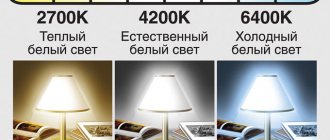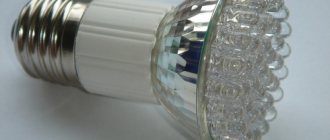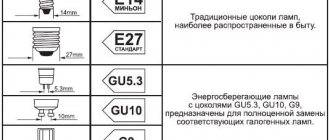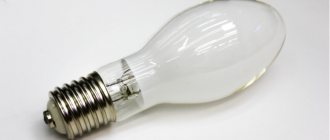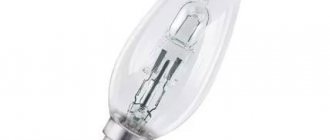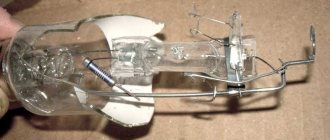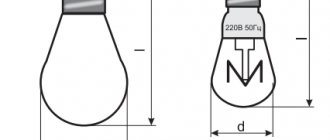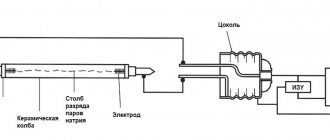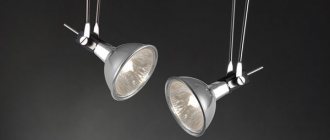Design features of the gu10 base
Appearance and overall dimensions
It is noticeable from the drawing that there are thickenings at the ends of the contacts of the base. These are the main design differences between the gu10 and other pin models.
The main purpose of the thickenings is strong fixation in the lamp socket. In addition, lamps with gu10 are simply and quickly inserted into the socket: just insert the light source and turn it slightly. The contact will not be lost during operation.
Additionally, such a base ensures electrical safety: gu10 are used only in networks with a voltage of 220 V. They cannot be inserted into the socket of low-voltage lamps.
The marking of the caps is quite simple: the letters indicate the pin type with rotary locking, and the numbers indicate the distance between the centers of the pins. In this case the distance is 10 mm.
Equipment
List of devices used:
- thermal imager: Seek Thermal Compact PRO
- photometric sphere: SpectraLight DIY-05
- wattmeter: Robiton PM-3M
- spectrometer: UPRtek MK350
- Luxmeter: Radex Lupine
All devices are tested and adjusted in certified lighting and electrical laboratories.
Types of lamps with gu10 base
Halogen
The device is similar to incandescent lamps. The main difference is in the composition of the buffer mixture that fills the glass flask: bromine and iodine vapors are added to the “halogens”. Due to halogen vapor, service life (up to 4000 hours) and light output (17-22 lm/W) are increased. They shine with a warm, even yellow light. They are inexpensive. However, they consume a lot of electricity, depend on mains voltage fluctuations and get very hot during operation (over 250⁰C). In addition, they should not be touched with bare hands to avoid premature breakdowns.
LED
LED lamps are characterized by maximum light output (80-120 lm/W) and service life (up to 50,000 hours). They consume a minimal amount of electricity. The color temperature is in the range of 2800-6500 K, which allows you to choose the light that is most pleasing to the eye. Some models are compatible with dimmers. Scattering angle from 12 to 36⁰. With a special diffuser, it increases to 60⁰.
Important parameters that affect the quality of the luminous flux are the pulsation coefficient and the color rendering index. It is better to choose light sources with a pulsation coefficient from 5 to 30% (the lower the better) and a color rendering index above 80. With such indicators, your eyes will not get tired, and colors will not be distorted.
Disadvantages include high price, dependence of operation on the stability of the network voltage and physical degradation of LEDs, which leads to a decrease in brightness during operation.
As an example, consider a gu10 LED with a luminous flux of 400 lm. Let's take a mid-price lamp: NAVIGATOR 5W GU10 400lm 4000K 230V spot PAR5. Such a light source costs an average of 90 rubles.
NAVIGATOR 5W GU10 400lm 4000K 230V spot PAR5
Power is 5 W. Color temperature is 4000 K, which corresponds to neutral white light. The lamp is made in the form of a spot, the bulb is matte. The diameter is 50 mm, length is 57 mm. A good color rendering index is 89. There is no dimming function. Rated service life is 35,000 hours. Power equivalent to a 35-watt incandescent lamp.
Heat
To measure the temperature of the housing and LEDs, samples are heated with a diffuser. Immediately before measurement, the diffuser is removed and measurements are taken.
| — | 6W GU10 | 10W GU10 |
| LEDs | 83° | 86° |
| Frame | 71° | 78° |
Modern LEDs used in general-purpose lamps, according to the specification, can heat up to an average of 120-125 degrees without losing their declared characteristics. If the temperature of the LEDs is below 100°, then this is a good indicator.
When tested, the LEDs of Spectrum LED bulbs showed temperatures of 83 and 86 degrees, that is, they operate in a comfortable temperature range, which means you can expect a long service life.
What are the differences between gu10 LED lamps and halogen lamps?
"Halogen" gu10
LED light sources are gradually replacing halogen ones. This comes with some very significant advantages.
Firstly, saving energy. To create an equal luminous flux, an LED light source needs up to 8 times less power. Of course, LEDs themselves cost more, but with long-term use, after 1-2 years, electricity bills will decrease noticeably. (The calculation applies to the lighting of rooms with the lights always on).
Secondly, LEDs heat up very little (up to 50-60⁰С; halogen ones - over 250⁰С). This is important for spotlights and lighting built into suspended ceilings, for example, in kitchen cabinets.
Thirdly, led gu10 is made moisture-resistant and shock-resistant. However, an LED lamp can work even with a damaged bulb.
Fourthly, if dimming is necessary, then LED lamps are the best option. Halogen light sources maintain their performance at maximum voltage. When it decreases, they turn into ordinary incandescent lamps. Therefore, dimming them is technically possible, but physically does not make sense. Dimmable LED bulbs cost more than conventional bulbs, but actually change their brightness as they operate, reducing energy costs.
When replacing halogen lamps with LED lamps in a particular lamp, pay attention to the overall dimensions: often light sources of different types with a similar luminous flux differ in size.
In addition to their sizes, these types differ in the direction of the light flux: the angle of incidence of light in halogen lamps is wider than in LED lamps. Therefore, when replacing some light bulbs with others, it is worth taking this parameter into account so that the overall illumination does not decrease. But for narrowly focused illumination, LED bulbs are the optimal solution.
Energy consumption
We measure power using a wattmeter and an adapter from the GU10 to E27 base. Real energy consumption turned out to be lower than stated by 9% for 6 W and 5% for 10 W, which means we will pay less for electricity than expected.
| — | 6W GU10 | 10W GU10 |
| Energy consumption | 5.44W | 8.52W |
Quality brands manufacturers of led lamps gu10
Like many other LED light sources, gu10 has global manufacturers that have proven themselves. This is Osram, Philips. Their products meet international standards, although they are expensive.
Russian manufacturers Navigator, Gauss, Uniel produce good products at lower prices.
Products from Kreonix, X-Flash, Lexman can also be called good. But for some Lexman models, the actual pulsation coefficient exceeds the declared one.
In addition, many companies have defective products.
Package
The packaging is made of glossy cardboard, pictograms and generally accepted symbols are used to indicate characteristics, and explanations are provided in all European languages.
Device and materials used
To understand the design of the plinths, you first need to find out what functions this part performs and what characteristics it must meet:
- The base acts as a conductor of electricity from the socket to the light bulb.
- Used to fix an element.
- Must be able to withstand operating temperature.
Overheating is dangerous for light bulbs.
The terminals of incandescent lamps are usually fixed with soft solders, the melting point of which is 180 degrees. Accordingly, the conclusions should not heat up to high levels. To compensate for thermal expansion, the cartridges have spring contacts.
Metals and plastics are used in the production of different types of bases. Metal elements are necessary for connecting and transmitting current.
Metal is a good conductor.
Pin option
When choosing, you need to focus on the distance between the contacts (pins). If the number of protruding elements is more than 2, the diameter of the holder circle becomes a guide. Depending on which versions of the lamp with pin holder are selected, it becomes possible to connect the lighting system to a power source of 220 volts or 12/24 volts.
The G4 holder can be found in halogen lighting elements designed to be connected to a 12/24 volt power source. Purpose – spot light, built-in lighting systems. Low-voltage lamps with such a holder can also be LED. The G5 version is used in luminescent analogues, for example T5.
The GU5.3 holder is part of lamps whose intended purpose is built-in lighting systems. This option is included in the design of LED and halogen lamps; it is suitable for a light source of the MR16 type, which, in turn, is used to organize the illumination of display cases, niches and decorative lighting. The power source can be a 12/24 volt or 220 volt power supply.
A special feature of GU10 is flattening at the end sections of the contact elements, which contributes to a more reliable connection with the cartridge. Light sources with such a contact part are powered by a 220 volt network.
Analogue GU6.35 - similar in characteristics to the GU5.3 version, but the distance between the pins is 6.5 mm, and only a 220 volt AC network can act as a power source. While the G5 type is characterized by contact elements in the form of pins, the G9 version is equipped with elongated hinges. The distance between them is 9 mm. These types of lighting sources are used when organizing accent lighting and decorative lighting.
Design G13 is a common option, used in LED and energy-saving fluorescent light sources with a cylindrical bulb shape. Thanks to this feature, the named types are interchangeable.
Option G23
The distance between the pins is 13 mm. Another version of G23 is slightly different in configuration, since in addition to the pins, the holder also has a plastic protrusion. Fastening is carried out by installing contact elements in a socket with holes.
Compact fluorescent lamp sockets
An analogue of the G53 holder is characterized by a significant distance between the pins - 53 mm. The intended purpose of lamps with such a contact element is directional light in shopping areas, restaurants, galleries. The GX53 version is used in light bulbs for installation in suspended and suspended ceiling structures. The pins are shaped similar to the GU10 pins. When installed, the light turns.
Selecting a lamp based on the base type
First of all, it is necessary to determine which network the connection will be made to: 12/24 V, 220 V, because different types of holders can be designed for connection to networks with different parameters. The choice of contact element for halogen, LED and energy-saving lamps is made based on the design of the lamp in which it is installed.
Each option is designed for use in certain conditions. There are versions for permanent and variable networks. In addition, you can choose a light bulb holder for a lighting fixture for different purposes: recessed or pendant lamps, directional or diffuse lighting options, functional or decorative lamps.
Where can I buy?
You can purchase Spectrum LED lamps with a GU10 base in Yandex Market and in the online store of the official distributor TSC Teplomarket LLC, which provided samples.
Link to GU10 6W and GU10 10W.
Author: Sergey Kazantsev
Samples were tested in a lighting laboratory, official website led-obzor.ru.
I have been working since 2015. I test LED lamps for the home, LED strips, lamps, spotlights. I test automotive LED lamps, halogen and xenon, fog lights, daytime running lights, LED lenses according to GOST. I use low-beam headlights, xenon and halogen lenses, and fog lights.
Addressing the audience. Before you start getting indignant and asking questions, try to read the material carefully. Half of the questions arise because they were not read carefully.
Marking
The domestic designation of energy-saving light bulbs contains a letter indicating the type:
- L – luminescent;
- B – white light;
- TB – white with a warm tint;
- D – daytime color;
- C – improved color rendering;
- E – improved environmental performance;
International designation is a digital designation, where the first digit shows the color rendering index, and the rest indicate the color temperature in hundreds of degrees Kelvin.
Table of characteristics of various types of light sources:
Based on the type of base, energy-saving sources are divided into:
Plinth designation:
- 2D – curved configuration, in the shape of a square. The base has the shape of a rectangle 60 x 36 mm. Power – 16, 28, 36 W.
- G23 – has the shape of a tube folded in half. Power 5 – 14 W.
- 2G7 - similar to G23, this type works with ballasts. The base has 4 contacts.
- G24 – the shape is similar to G23, it has the shape of a quadruple folded tube. Output power 10 – 36 W.
- G53 – disc-shaped, 16-20 mm thick and 73 mm in diameter. The device has a curved shape. The power of this type is about 6 -11 W.
- E14, E27, E40 - have a screw-in Edison type base. The digital designation indicates the diameter of the base.
How to choose
Before purchasing a gu 10 light bulb, you should pay close attention to the technical characteristics. In order to have an idea of how bright the light will be, as well as how natural the colors of the objects in the room will remain, it is worth studying the following:
- how light rays arrive;
- to what temperature the light heats up, which means what color it will shine;
- color rendering level.
It is these features that are responsible for how high quality the lighting will be.
As mentioned above, LED light bulbs require a power supply of 220 Volts. If the lamp was originally equipped with a halogen lamp marked gu 10, then certain requirements will be imposed on a lamp with diodes of a similar base. For example, the voltage power should be set to the one that was used previously.
